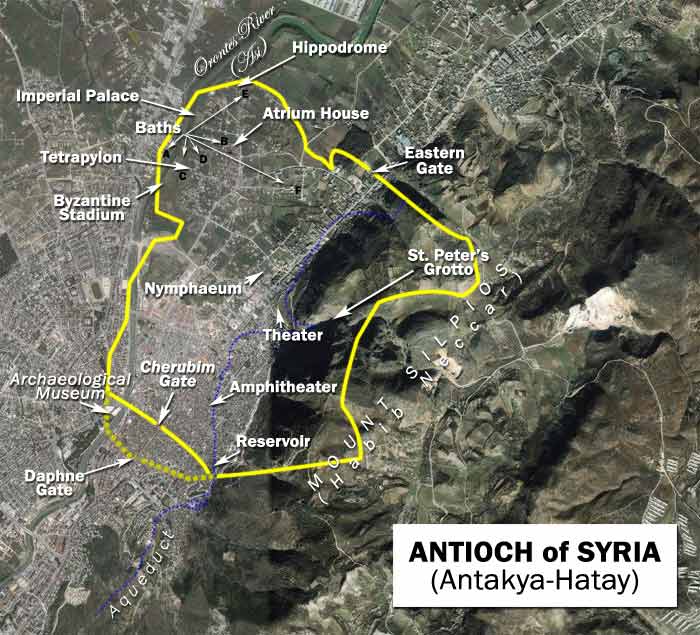
Many locations only approximate.
Plan of ancient city
View with labels
Hellenistic Antioch Roman Antioch
Zoom out to Asia Minor satellite view
Zoom way out to “Lands of the Eastern Mediterranean”
Paul’s First Missionary Journey
Paul’s Second Missionary Journey
Paul’s Third Missionary Journey
Ancient Antioch is also known as “Antioch of Syria,” “Syrian Antioch,” or “Antioch on the Orontes” to distinguish it from many other cities by the same name, including the Antioch of Acts 13, “Antioch of Pisidia” or “Pisidian Antioch.” In reality, “Antioch of Syria” is not located in modern Syria but in neighboring Turkey. What’s more, its modern name is not Antioch but Antakya, a bustling city with a 2020 population of 210,000.
The river once called the Orontes is now known as Asi. As you will see from the other views, the course of the Orontes has changed since ancient times. This is due in part to modern flood-control efforts. The mountain at whose feet Antioch lies nestled, once known as Mount Silpios (or Silpius), is now called Habib Neccar, rising 373 m. (1027 ft.) above the city to 440 m. (1211 ft.) above sea level.
Not much is left to see of ancient Antioch. If you visit the city, be sure to spend many hours at the archaeological museum, which has one of the best collections of ancient mosaics in the world. You will also want to visit the Grotto of St. Peter (S. Pierre). This cave was apparently one of the first places Christians met in Antioch and claims the distinction of being the oldest Christian church in the world.
For more on the ancient city, go to the other views.
Want to dive deeper?
The following are recommended to help you look deeper into the history and archaeology of Antioch of Syria.
Recommended for purchase

Jerome Crowe – From Jerusalem to Antioch: The Gospel Across Cultures (Liturgical Press, 1997) – What happens when the gospel is carried from one world to another and a Christian community is born in a new culture? How does the dynamism of the gospel reshape the culture that accepts it? How does that culture enrich the gospel with new ways of self-expression? Crowe explains what happened when Jewish Christians carried the gospel from the Jewish world of Jerusalem into the Hellenistic world of Antioch to found the first “Christian” community. It presents the results of modern research on the church of Jerusalem and the church of Antioch.
Hatay Muzesi – Hatay Museum and Environs (1991)
Claude E. Fant & Mitchell G. Reddish – A Guide to Biblical Sites in Greece and Turkey (Oxford, 2003). Excerpt
Christine Kondoleon – Antioch: The Lost Ancient City (Princeton, 2000) – This lavish exhibition catalog brings ancient Antioch to life. Featuring 118 objects excavated from the city’s ruins, all reproduced in color. Kondoleon displays and describes the excavated artifacts–mosaics, sculpture, glass, metalwork, coins–within their architectural and cultural contexts, thereby evoking the street life as well as the domestic lives of Antioch’s citizens.
CD-ROM: Turkey: Pictorial Library of Bible Lands (2004)
For online reading:
Edmond S. Bouchier – A Short History of Antioch: 300 B.C. – A.D. 1268 (Oxford: Basil Blackwell, 1921) – try the flip book version.
hristine Eslik – Current excavations
Sacred Destinations – “Cave Church of St. Peter”
Christopher Ecclestone – “Antiochepedia” – This is perhaps the most complete site dedicated to the study of ancient Antioch of Syria. It has a wealth of material for understanding the ancient city and its archaeology and contains a helpful bibliography. CAUTION: This site is very slow in opening and refreshing.
Troels Myrup Kristensen. The Archaeology of Antioch, Part I and The Archaeology of Antioch, Part II – Kristensen is a post-graduate classical archaeology student at a university in Denmark, involved in an ongoing project: “Art & Sociel Identities in Late Antiquity.”
Dick Osseman’s excellent photos of Antakya-Hatay, the St. Peter’s Grotto, and the Archaeological Museum’s fabulous collection of ancient mosaics and other objects.
